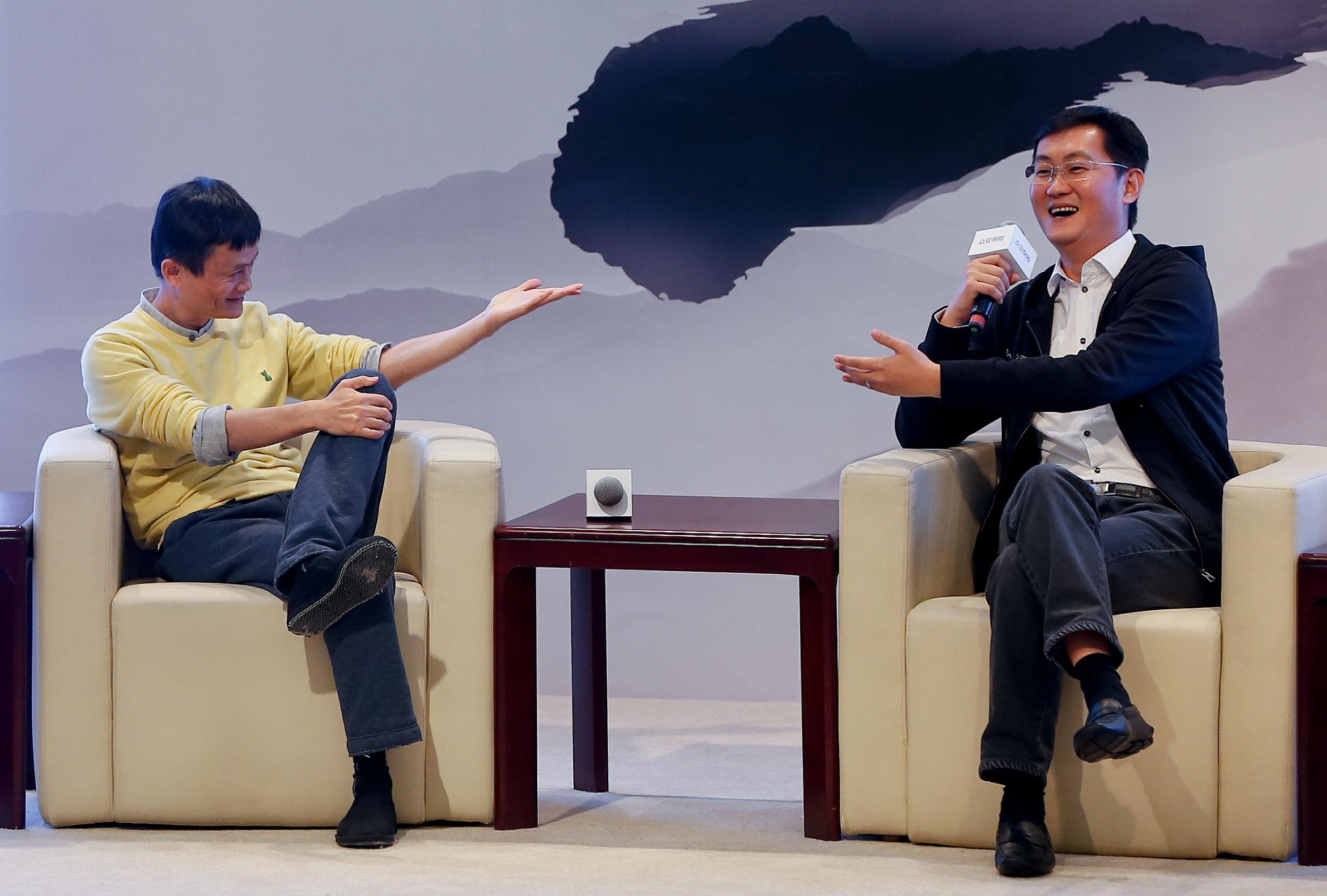


|
中国本土的两大科技巨头,阿里巴巴和腾讯,基本上都依靠中国国内市场赚钱,然而像谷歌、亚马逊和Facebook这样的科技公司,有三分之一甚至更多的收入来自海外市场。但是,双方在东南亚却掀开了新的篇章。在过去几年中,阿里巴巴和腾讯在这一片土地上砸下了数十亿美元,以收购该地区领先的科技初创企业的股权。 这两家巨头公司的投资毫无疑问刺激了东南亚企业的增长和扩张,但也使得这些公司的管理层和战略发生了变化。从本质上来说,阿里巴巴和腾讯正在打造与其中国竞争格局类似的东南亚科技生态圈,并要求这些东南亚本土公司选边站队。 对于中国的科技巨头而言,东南亚的吸引力无疑是巨大的。东盟的10个国家拥有6.4亿人口,如果东盟是一个单一国家,那么它将成为世界第三人口大国以及第六大经济体。此外,东盟在地理位置上十分靠近中国,拥有2500多万华人,其中很多人已经十分熟悉阿里巴巴和腾讯所提供的服务。 尽管东南亚有着极其多元化的种族、宗教、文化和语言,但这一地区与中国有着一个重要的共同之处:都有一个新兴的、深谙科技的中产阶级。一份由谷歌和新加坡主权基金淡马锡(Temasek)于2017年共同撰写的报告指出,预计到2020年,东南亚地区活跃网民数量将从2017年的3.3亿增至4.8亿。这一报告预测,到2025年,东南亚地区的互联网经济(包括在线视频、旅游、打车和电商市场)将增至2000亿美元,达到2017年500亿美元的4倍。 虽说阿里巴巴和腾讯在东南亚支持的企业并不具备其自身的规模,但却是其所在市场出类拔萃的公司。这对于马云和马化腾而言,要想把国内竞争升级为一场真正的国际竞争,抢夺东南亚公司不失为一个可行的跳板。 阿里下注电商 到目前为止,阿里巴巴在东南亚的投资比腾讯更放得开。2016年4月,阿里巴巴斥资10亿美元收购了东南亚最大的本土电商品牌Lazada 51%的股份,这笔交易是中国在整个东南亚地区科技行业开展的第一次大规模投资。2017年,阿里巴巴向Lazada额外注资10亿美元,将持股比例从51%提高到83%。2018年2月,阿里巴巴再次加倍注资,使总投资额达到了40亿美元,并任命彭蕾担任公司的首席执行官,后者是阿里巴巴最初的18位创始人之一。 Lazada由德国初创公司Rocket Internet于2011年组建,总部位于新加坡。最初,Lazada完全复刻了亚马逊的经营模式,即在大型中转中心建立仓库积累库存,并负责对销售的产品进行配送。但在阿里巴巴的指导下,这家公司正在从亚马逊模式向淘宝模式进行转型,转身成为一个数字平台商,把客户和商家通过这一平台对接起来,并且把配送业务外包出去。在6个东南亚国家,现已经有超过5.6亿用户使用Lazada这一平台。根据分析师预测,彭蕾将为Lazada获得淘宝那样的飞速发展奠定基础,同时把这家公司一起整合到阿里巴巴旗下。彭蕾本人早年曾担任阿里巴巴的人力资源主管,后来负责蚂蚁金服并使其迅速扩张。 除此之外,阿里巴巴不惜重金押注印度尼西亚最大的电商公司Tokopedia。Tokopedia的创始人认为Lazada将成为其最大的竞争对手,所以原本打算和腾讯联手。随后,Tokopedia和腾讯的高管进行了深入的讨论,甚至和腾讯的主要战略合作伙伴京东达成了一份条件清单。然而在2017年8月,由于阿里巴巴早期投资者软银孙正义的干预,阿里巴巴乘虚而入,在Tokopedia和腾讯达成交易之前领投11亿美元入股Tokopedia。 腾讯下注游戏 腾讯持有新加坡游戏应用公司 SEA 40%的股份,后者于2017年10月在美国纽交所成功上市,所筹资金超过10亿美元。与大东家腾讯一样,SEA的大部分收入来自游戏和网络服务,而腾讯则在不断鼓励SEA向电商和移动支付领域进军。 SEA的营收额在增加,但是亏损同样在增加,很大程度上要归结于SEA对电商平台Shopee.com的投资。截至2018年3月的前三个月,SEA的营收达到了1.55亿美元,同比增长65%,但其当季的亏损却超过了2.15亿美元,是上年同期的三倍。在今年2月,SEA的创始人尼克?纳什宣布辞去首席执行官一职。 网约车市场:一起下注 腾讯在东南亚还有一项重要投资:Go-Jek。Go-Jek是一家印度尼西亚的初创公司,最早是一家摩托车叫车服务公司,而现在已拓展至汽车叫车服务。去年夏天,腾讯领投12亿美元入股Go-Jek,并鼓励Go-Jek把打车app改造成像微信一样的多功能通用平台。 与此同时,阿里巴巴也在和一家新加坡叫车公司Grab进行磋商,而Grab正是Go-Jek的对手。对于Grab而言,之前的几轮融资已让其声名远扬:在6月早些时候,Grab从丰田获得了10亿美元的融资,目前其估值已经超过70亿美元,成为了该地区最有价值的初创公司。Grab由哈佛商学院的两名同班同学Anthony Tan和Hooi Ling Tan创立。Grab在东南亚的8个国家开展业务,在该地区占据着市场主导地位,目前每天的下单量超过了600万。 在今年3月,Uber宣布退出东南亚市场,并把这一地区内所有业务以16亿美元的价格打包卖给了Grab(同时获取Grab 27.5%的权益),这是Grab的又一次胜利,但却召来了新加坡、菲律宾和泰国反垄断机构的调查。 紧接着,Grab的竞争公司Go-Jek宣布计划投资5亿美元,在新加坡、菲律宾和泰国进行扩张,并进军另一个Grab经营的市场——越南。彭博在6月初称,包括腾讯和华平投资在内的Go-Jek投资者为Go-Jek额外注资10亿美元,用于与Grab开展竞争。(BT365的网址是多少) 本文的另外一个版本刊于2018年7月1日的《财富》杂志,标题为《两大中国企业巨头在东南亚的对弈》。 译者:Pessy 审校:夏林 |
CHINA’S TWO TECHNOLOGY giants are mostly homebodies. Unlike Alphabet’s Google, Amazon and Facebook, which rely on overseas markets for a third or more of their total sales, Alibaba and Tencent collect only a small fraction of their revenue outside of China. But a different story is unfolding in Southeast Asia where, over the last several years, Alibaba and Tencent have spent billions of dollars to secure major equity stakes in the region’s leading tech startups. Investments from the two Chinese giants have stimulated growth and expansion, but have also forced changes in leadership and strategy. In essence, Alibaba and Tencent are creating rival tech ecosystems that mirror their competition in China, and are requiring local startups to choose sides. For China’s tech titans, Southeast Asia has obvious appeal. The 10 markets that make up the Association of Southeast Asian Nations (ASEAN) are home to 640 million people. Were ASEAN a single country, it would be the world’s third-most-populous nation and boast the sixth-largest economy. In addition to its geographical proximity to China, ASEAN is home to more than 25 million ethnic Chinese, many of them already familiar with the services the two Chinese companies offer. And for all its diversity—ethnic, cultural, religious and linguistic—Southeast Asia shares an important characteristic with China: a rising, tech-savvy middle-class. A 2017 report co-authored by Google and Temasek, Singapore’s sovereign wealth fund, forecasts that the number of active Internet users in Southeast Asia will reach 480 million by 2020, up from 330 million last year. The study predicts the region’s Internet economy—which it defines as the online media, travel, ride-hailing and e-commerce markets—will grow to $200 billion by 2025, a fourfold increase over last year’s $50 billion. While none of the Southeast Asian ventures that Alibaba and Tencent have backed has anything like the kind of scale that the Chinese giants command, they’re very prominent in their home markets. And that could make them viable springboards for any effort by Jack Ma and Pony Ma to turn their competition into a truly global one. Alibaba’s e-commerce To date, Alibaba has invested more boldly than Tencent in Southeast Asia. Alibaba made the first major Chinese investment in the region’s tech sector in April 2016 when it paid $1 billion for a 51% stake in Lazada, Southeast Asia’s largest e-commerce platform. Last year, Alibaba invested an additional $1 billion, boosting its stake to 83%. In February, the Chinese tech giant doubled down again, bringing its total investment to $4 billion and installing Lucy Peng, one of Alibaba’s original 18 founders, as the company’s CEO. Lazada, based in Singapore, was launched in 2011 by German startup studio Rocket Internet. It began as an Amazon clone, accumulating inventory in large fulfillment centers and taking direct responsibility for delivering the products it sold. But now, under Alibaba’s direction, the venture is evolving away from the Amazon model to function more like its Chinese parent, which acts as a digital middleman connecting customers to outside vendors and outsources delivery. More than 560 million customers in six Southeast Asian markets use Lazada’s platform. Analysts expect Peng, who headed human resources at Alibaba in the company’s early years and later led the rapid expansion of mobile payment affiliate Ant Financial, to lay the groundwork for a similar takeoff at Lazada, while integrating the Southeast Asian startup’s operations into Alibaba’s. Alibaba has also bet big on Tokopedia, Indonesia’s largest e-commerce firm. Tokopedia’s founders considered Lazada their main rival and were expected to join forces with Tencent. They had held extensive discussions with Tencent executives and even completed a term-sheet with JD.com, one of Tencent’s key strategic allies. But in August 2017, thanks partly to the aggressive intervention of Softbank’s Masayoshi Son, an early Alibaba backer, Alibaba pre-empted a Tokopedia deal with Tencent by swooping in and leading a $1.1 billion funding round. Tencent’s gaming-plus play Tencent, for its part, owns a 40% stake in SEA, a Singapore-based gaming app that raised more than $1 billion in an October 2017 listing on the New York Stock Exchange. Like Tencent, SEA collects much of its revenue through games and web services. The Chinese company has encouraged SEA to broaden its platform into e-commerce and financial payments. Revenue is rising at SEA, but so are losses, thanks largely to its investment in its mobile e-commerce platform, Shopee.com. In the three months to March, SEA reported revenue of $155 million, up 65% from the same period a year earlier. But net losses during the quarter exceeded $215 million, triple the previous year. In February, founder Nick Nash announced that he would step down as CEO. Transportation: Up for Grab(s) Tencent’s other major investment in the region is Go-Jek, an Indonesian startup that began as a motorbike-on-demand service and has expanded into ride-hailing for four-wheeled vehicles. Tencent, which led a $1.2 billion funding round for the venture last summer, has encouraged Go-Jek to transform its ride-hailing app into an all-purpose platform similar to Tencent’s popular WeChat app. Alibaba is reportedly in talks to invest in Grab, the Singapore-based ride-hailing venture that is Go-Jek’s nemesis. But other funding rounds have been making headlines: In earlier June, Grab secured a $1 billion investment from Toyota, which valued the company at more than $7 billion, making it the region’s most valuable startup. Grab, co-founded by Harvard Business School classmates Anthony Tan and Hooi Ling Tan, operates in eight Southeast Asian markets and dominates ride-hailing in the region with daily orders of over 6 million. Grab scored another victory this March when San Francisco-based Uber announced plans to withdraw from Southeast Asia and sell its entire operations in the region to Grab for $1.6 billion and a 27.5 percent equity stake. That acquisition has drawn the scrutiny of anti-trust regulators in Singapore, the Philippines and Thailand. Immediately afterwards, Go-Jek announced plans to invest $500 million to expand into those three markets along with another where Grab operates, Vietnam. In early June, according to Bloomberg, Go-Jek investors including Tencent and Warburg Pincus offered the company an addition $1 billion in funding to compete with Grab. A version of this article appears in the July 1, 2018 issue of Fortune with the headline “Chess Pieces in Southeast Asia.” |
最新文章




